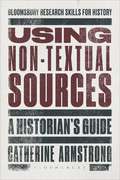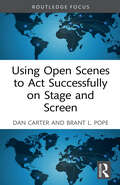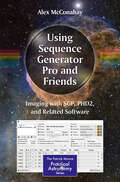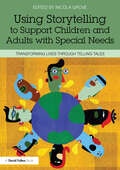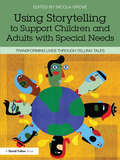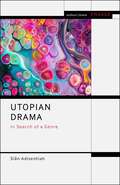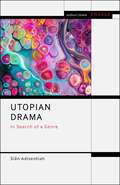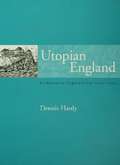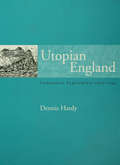- Table View
- List View
Using History to Develop Thinking Skills at Key Stage 2
by Belle WallaceThis practical resource book presents ways in which teachers can help to develop children's problem solving and thinking skills through a range of history topics. The book contains classroom-based activities that have been tried and evaluated by teachers and children. Most importantly, the contributors also show how the skills developed through rigorous historical investigations can be used across all areas of the curriculum. Topics covered include a detailed account of a world history investigation on Ancient Egypt; teaching historical skills using artifacts; small group work on local history, the Vikings and the Second World War; working in depth on aspects of the Tudors; and developing writing skills through a study of the Romans.
Using History to Develop Thinking Skills at Key Stage 2
by Belle WallaceThis practical resource book presents ways in which teachers can help to develop children's problem solving and thinking skills through a range of history topics. The book contains classroom-based activities that have been tried and evaluated by teachers and children. Most importantly, the contributors also show how the skills developed through rigorous historical investigations can be used across all areas of the curriculum. Topics covered include a detailed account of a world history investigation on Ancient Egypt; teaching historical skills using artifacts; small group work on local history, the Vikings and the Second World War; working in depth on aspects of the Tudors; and developing writing skills through a study of the Romans.
Using Museums as an Educational Resource: An Introductory Handbook for Students and Teachers
by Graeme K. TalboysVisits to museums have long been an important aspect of the education of young people and in recent years it has been increasingly recognised that education is core to the purpose of the museum. Not only do they introduce students to the many and varied forms of our material culture, they also introduce them to social, historical and scientific encounters that are difficult to find elsewhere. The second edition of this popular book takes account of the ongoing changes in both museums and education to provide a comprehensive introduction for student teachers, practising teachers and other educators to all that is required to make good educational use of museums. It explores what a museum is, their value in primary and secondary education and why they require special teaching skills. It then goes on to look at the practicalities of planning, preparing and conducting a visit, including risk assessment. Next, it introduces the basic skills involved in working with the resources that are required to make the best educational use of museums, including online and digital resources. Finally, the author considers ways of following-up work done outside the classroom, including some of the longer term strategies that teachers should consider.
Using Museums as an Educational Resource: An Introductory Handbook for Students and Teachers
by Graeme K. TalboysVisits to museums have long been an important aspect of the education of young people and in recent years it has been increasingly recognised that education is core to the purpose of the museum. Not only do they introduce students to the many and varied forms of our material culture, they also introduce them to social, historical and scientific encounters that are difficult to find elsewhere. The second edition of this popular book takes account of the ongoing changes in both museums and education to provide a comprehensive introduction for student teachers, practising teachers and other educators to all that is required to make good educational use of museums. It explores what a museum is, their value in primary and secondary education and why they require special teaching skills. It then goes on to look at the practicalities of planning, preparing and conducting a visit, including risk assessment. Next, it introduces the basic skills involved in working with the resources that are required to make the best educational use of museums, including online and digital resources. Finally, the author considers ways of following-up work done outside the classroom, including some of the longer term strategies that teachers should consider.
Using Non-Textual Sources: A Historian's Guide (Bloomsbury Research Skills for History)
by Catherine ArmstrongUsing Non-Textual Sources provides history students with the theoretical background and skills to interpret non-textual sources. It introduces the full range of non-textual sources used by historians and offers practical guidance on how to interpret them and incorporate them into essays and dissertations. In addition to this, the book posits a theoretical framework that justifies the use of these items as historical sources and explains how they can be used to further understand the past.There is coverage of the creation, production and distribution of non-textual sources; the acquisition of skills to 'read' these sources analytically; and the meaning, significance and reliability of these forms of evidence. Using Non-Textual Sources includes a section on interdisciplinary non-textual source work, outlining what historians borrow from disciplines such as art history, archaeology, geography and media studies, as well as a discussion of how to locate these resources online and elsewhere in order to use them in essays and dissertations.Case studies, such as the Tudor religious propaganda painting Edward VI and the Pope, the 1954 John Ford Western The Searchers and the Hereford Mappa Mundi, are employed throughout to illustrate the functions of main source types. Photographs, cartoons, maps, artwork, audio clips, film, places and artifacts are all explored in a text that provides students with a comprehensive, cohesive and practical guide to using non-textual sources.
Using Non-Textual Sources: A Historian's Guide (Bloomsbury Research Skills for History)
by Catherine ArmstrongUsing Non-Textual Sources provides history students with the theoretical background and skills to interpret non-textual sources. It introduces the full range of non-textual sources used by historians and offers practical guidance on how to interpret them and incorporate them into essays and dissertations. In addition to this, the book posits a theoretical framework that justifies the use of these items as historical sources and explains how they can be used to further understand the past.There is coverage of the creation, production and distribution of non-textual sources; the acquisition of skills to 'read' these sources analytically; and the meaning, significance and reliability of these forms of evidence. Using Non-Textual Sources includes a section on interdisciplinary non-textual source work, outlining what historians borrow from disciplines such as art history, archaeology, geography and media studies, as well as a discussion of how to locate these resources online and elsewhere in order to use them in essays and dissertations.Case studies, such as the Tudor religious propaganda painting Edward VI and the Pope, the 1954 John Ford Western The Searchers and the Hereford Mappa Mundi, are employed throughout to illustrate the functions of main source types. Photographs, cartoons, maps, artwork, audio clips, film, places and artifacts are all explored in a text that provides students with a comprehensive, cohesive and practical guide to using non-textual sources.
Using Open Scenes to Act Successfully on Stage and Screen
by Dan Carter Brant L. PopeUsing Open Scenes as a "way in" to scripted material, this book establishes a foundational actor training methodology that can be applied to the performance of film or television acting, commercials, and theatrical realism. Unlike other methodologies, this unique approach is devoid of casting considerations or imposed identity, providing actors opportunities that do not rely on nor are restricted by age, gender, race, ethnicity, regional accent, body type, identity, or other defining or delimiting aspects that come into play during the casting process. This allows the actor to focus on personal authenticity as they develop their skills. This book will appeal to undergraduate students, acting teachers, and the contemporary actor seeking a career in film, television, or other electronic media. Visit the companion website www.usingopenscenestoactsuccessful.godaddysites.com for additional Open Scenes and more.
Using Open Scenes to Act Successfully on Stage and Screen
by Dan Carter Brant L. PopeUsing Open Scenes as a "way in" to scripted material, this book establishes a foundational actor training methodology that can be applied to the performance of film or television acting, commercials, and theatrical realism. Unlike other methodologies, this unique approach is devoid of casting considerations or imposed identity, providing actors opportunities that do not rely on nor are restricted by age, gender, race, ethnicity, regional accent, body type, identity, or other defining or delimiting aspects that come into play during the casting process. This allows the actor to focus on personal authenticity as they develop their skills. This book will appeal to undergraduate students, acting teachers, and the contemporary actor seeking a career in film, television, or other electronic media. Visit the companion website www.usingopenscenestoactsuccessful.godaddysites.com for additional Open Scenes and more.
Using Sequence Generator Pro and Friends: Imaging with SGP, PHD2, and Related Software (The Patrick Moore Practical Astronomy Series)
by Alex McConahayThis guide is specifically aimed at those who are using—or want to use—Sequence Generator Pro. SGP is a “session management” software package that controls the telescope, mount, camera, and ancillary equipment to target and secure images during a night of imaging astronomical objects.The book begins with a special tutorial to get up and running with SGP. With a comprehensive reference section, it takes the user in detail through the various aspects of user and equipment profiles, equipment definitions, the sequencer, and other essential elements of SGP. Finally, it focuses on how to get the most out of the ancillary programs—target databases, autoguiders, plate solvers, planetarium software, and other applications.Oftentimes, technical guides can end up being far denser than the processes they intend to explain. Many of the insights provided by SGP expert Alex McConahay are beyond what can be found in the official program documentation. In this book, the reader will find in-depth, yet straightforward practical advice on how to automate nightly astroimaging sessions with Sequence Generator Pro.
Using Storytelling to Support Children and Adults with Special Needs: Transforming lives through telling tales
by Nicola GroveThis innovative and wide-ranging book shows how storytelling can open new worlds for learners with or without special educational needs. With sections that outline both therapeutic and educational approaches, the leading practitioners who contribute to this practical resource draw on their extensive experience, and distil their own approaches for the reader to use as inspiration for their own lessons. Providing a highly accessible combination of theory and practice, the contributors to this book: define their own approach to storytelling describe the principles and theory that underpin their practice demonstrate how they work with different types of story provide extensive case-studies and assessment frameworks for a range of different special needs and age ranges provide some ‘top tips’ for practitioners who want to start using stories in this way. Using Storytelling to Support Children and Adults with Special Needs will be of interest to all education professionals as well as therapists, youth workers, counsellors, and storytellers and theatre practitioners working in special education.
Using Storytelling to Support Children and Adults with Special Needs: Transforming lives through telling tales
by Nicola Grove Nicola GrovesThis innovative and wide-ranging book shows how storytelling can open new worlds for learners with or without special educational needs. With sections that outline both therapeutic and educational approaches, the leading practitioners who contribute to this practical resource draw on their extensive experience, and distil their own approaches for the reader to use as inspiration for their own lessons. Providing a highly accessible combination of theory and practice, the contributors to this book: define their own approach to storytelling describe the principles and theory that underpin their practice demonstrate how they work with different types of story provide extensive case-studies and assessment frameworks for a range of different special needs and age ranges provide some ‘top tips’ for practitioners who want to start using stories in this way. Using Storytelling to Support Children and Adults with Special Needs will be of interest to all education professionals as well as therapists, youth workers, counsellors, and storytellers and theatre practitioners working in special education.
Using the Sky: A Dance
by Deborah HayIn the mid 1990’s Deborah Hay’s work took a new turn. From her early experiments with untrained dancers, and after a decade of focusing on solo work, the choreographer began to explore new grounds of choreographic notation and transmission by working with experienced performers and choreographers. Using the Sky: a dance follows a similar path as Hay’s previous books—Lamb at the Altar and My Body the Buddhist—by exploring her unrelenting quest for ways to both define and rethink her choreographic imagery through a broad range of alternately intimate, descriptive, poetic, analytical and often playful engagement with language and writing. This book is a reflection on the experiments that Hay set up for herself and her collaborators, and the ideas she discovered while choreographing four dances, If I Sing to You (2008), No Time to Fly (2010), A Lecture on the Performance of Beauty (2003), and the solo My Choreographed Body (2014). The works are revisited by unfolding a trove of notes and journal entries, resulting in a dance score in its own right, and providing an insight into Hay’s extensive legacy and her profound influence on the current conversations in contemporary performance arts.
Using the Sky
by Deborah HayIn the mid 1990’s Deborah Hay’s work took a new turn. From her early experiments with untrained dancers, and after a decade of focusing on solo work, the choreographer began to explore new grounds of choreographic notation and transmission by working with experienced performers and choreographers. Using the Sky: a dance follows a similar path as Hay’s previous books—Lamb at the Altar and My Body the Buddhist—by exploring her unrelenting quest for ways to both define and rethink her choreographic imagery through a broad range of alternately intimate, descriptive, poetic, analytical and often playful engagement with language and writing. This book is a reflection on the experiments that Hay set up for herself and her collaborators, and the ideas she discovered while choreographing four dances, If I Sing to You (2008), No Time to Fly (2010), A Lecture on the Performance of Beauty (2003), and the solo My Choreographed Body (2014). The works are revisited by unfolding a trove of notes and journal entries, resulting in a dance score in its own right, and providing an insight into Hay’s extensive legacy and her profound influence on the current conversations in contemporary performance arts.
Using the Visual Arts for Cross-curricular Teaching and Learning: Imaginative ideas for the primary school
by Karen Hosack JanesAs schools are being encouraged to develop more flexible and creative approaches to education, Using the Visual Arts for Cross-curricular Teaching and Learning provides practical guidance and ideas on using the visual arts as a starting point for imaginative, effective learning across a wide range of curriculum subjects. Underpinned by established and current educational thinking, it uses real-life examples to explore how this approach has been used successfully by individual class teachers and as whole-school projects. Offering proven strategies supporting the principles of personalized learning, it will help you involve children in devising cross-curricular themes and setting their own lines of enquiry. Supplemented throughout with case studies and ideas for great artworks to get projects started, as well as examples of children’s own work, it explores: developing individual pupils' talent and respect for their own and other cultures; using a single painting as a starting point for learning in a range of subjects; finding inspiration for your own cross-curricular projects using the visual arts; underpinning all activities with educational purpose; planning for and assessing progression in learning; discovering and using art resources in your region. The tried and tested strategies in Using the Visual Arts for Cross-curricular Teaching and Learning will give all primary school teachers the confidence to explore the benefits of placing the visual arts at the centre of a creative, appealing curriculum.
Using the Visual Arts for Cross-curricular Teaching and Learning: Imaginative ideas for the primary school
by Karen Hosack JanesAs schools are being encouraged to develop more flexible and creative approaches to education, Using the Visual Arts for Cross-curricular Teaching and Learning provides practical guidance and ideas on using the visual arts as a starting point for imaginative, effective learning across a wide range of curriculum subjects. Underpinned by established and current educational thinking, it uses real-life examples to explore how this approach has been used successfully by individual class teachers and as whole-school projects. Offering proven strategies supporting the principles of personalized learning, it will help you involve children in devising cross-curricular themes and setting their own lines of enquiry. Supplemented throughout with case studies and ideas for great artworks to get projects started, as well as examples of children’s own work, it explores: developing individual pupils' talent and respect for their own and other cultures; using a single painting as a starting point for learning in a range of subjects; finding inspiration for your own cross-curricular projects using the visual arts; underpinning all activities with educational purpose; planning for and assessing progression in learning; discovering and using art resources in your region. The tried and tested strategies in Using the Visual Arts for Cross-curricular Teaching and Learning will give all primary school teachers the confidence to explore the benefits of placing the visual arts at the centre of a creative, appealing curriculum.
The Usual Suspects (BFI Film Classics)
by Ernest LarsonA heist thriller with a dazzling twist in the tail, this film 'The Usual Suspects' has seen its reputation grow until it is now a major cult movie. Ernest Larsen examines the film's sophistcated narrative structure and the new spin it puts on an old genre.
The Usual Suspects (BFI Film Classics)
by Ernest LarsonA heist thriller with a dazzling twist in the tail, this film 'The Usual Suspects' has seen its reputation grow until it is now a major cult movie. Ernest Larsen examines the film's sophistcated narrative structure and the new spin it puts on an old genre.
Utopian Adventure: The Corviale Void
by Victoria WatsonThis book is about contemporary issues in architecture and urbanism, taking the form of a project for The Corviale Void, a one kilometre long strip of urban space, immured in the notorious Corviale housing development in the Southwestern sector of Rome. Corviale is a bizarre object, single-minded in its idea, the history of Corviale can be traced to debates in Italian architecture culture of the 1960’s, including Aldo Rossi’s objection to urbanisation, as articulated in his books and projects. On the one hand the project for the Corviale Void begins with one of the original theorists of modern urbanisation and architecture, Giovanni Battista Piranesi, looking into his fascination with the insides of walls. On the other hand the project begins with a new material form, The Air Grid. Like the forms appearing in Piranesi’s etchings, Air Grid is made from a kind of hatching, but Air Grid is hatched out of colour vectors, literally drawn into the air. The human eye is easily mesmerised by the Air Grid, scanning back and forth it reads the colour form as animated, in some sense alive. At the same time as the Italian architects were engaged in those activities that would eventually give birth to the Corviale Void, the painter Yves Klein, was creating The Architecture of the Air. Klein’s work is of special interest to the project of the Corviale Void because of the important role of colour in the development of his thinking about architecture. By attending to Klein’s parallel inquiry Air Grid is brought into dialogue with the philosophy of Arthur Schopenhauer, who was one of the first thinkers to develop a physiological theory of colour. The important thing about Schopenhauer’s thinking is the careful way he looked at physiological phenomena, regarding them as directly informed by metaphysical powers; for Schopenhauer Architecture too is a physiological matter and hence metaphysical. The concluding proposal for the Corviale Void presents a metaphysical archite
Utopian Adventure: The Corviale Void
by Victoria WatsonThis book is about contemporary issues in architecture and urbanism, taking the form of a project for The Corviale Void, a one kilometre long strip of urban space, immured in the notorious Corviale housing development in the Southwestern sector of Rome. Corviale is a bizarre object, single-minded in its idea, the history of Corviale can be traced to debates in Italian architecture culture of the 1960’s, including Aldo Rossi’s objection to urbanisation, as articulated in his books and projects. On the one hand the project for the Corviale Void begins with one of the original theorists of modern urbanisation and architecture, Giovanni Battista Piranesi, looking into his fascination with the insides of walls. On the other hand the project begins with a new material form, The Air Grid. Like the forms appearing in Piranesi’s etchings, Air Grid is made from a kind of hatching, but Air Grid is hatched out of colour vectors, literally drawn into the air. The human eye is easily mesmerised by the Air Grid, scanning back and forth it reads the colour form as animated, in some sense alive. At the same time as the Italian architects were engaged in those activities that would eventually give birth to the Corviale Void, the painter Yves Klein, was creating The Architecture of the Air. Klein’s work is of special interest to the project of the Corviale Void because of the important role of colour in the development of his thinking about architecture. By attending to Klein’s parallel inquiry Air Grid is brought into dialogue with the philosophy of Arthur Schopenhauer, who was one of the first thinkers to develop a physiological theory of colour. The important thing about Schopenhauer’s thinking is the careful way he looked at physiological phenomena, regarding them as directly informed by metaphysical powers; for Schopenhauer Architecture too is a physiological matter and hence metaphysical. The concluding proposal for the Corviale Void presents a metaphysical archite
Utopian Drama: In Search of a Genre (Methuen Drama Engage)
by Siân AdiseshiahAs the first full-length study to analyse utopian plays in Western drama from antiquity to the present, Utopian Drama: In Search of a Genre offers an illuminating appraisal of the objectives of utopianism as manifested in drama through the ages, and carefully ascertains the added value that live performance brings to the persuasion of utopian thought. Siân Adiseshiah scrutinises the distinctive intervention of utopian drama through its examination alongside the utopian prose tradition – in this way, the book establishes new ways of approaching utopian aesthetics and new ways of interpreting utopian drama. This book provides fresh understandings of the generic features of utopian plays, identifies the gains of establishing a new genre, and ascertains ways in which this genre functions as political theatre. Referring to over 40 plays, of which 18 are examined in detail, Utopian Drama traces the emergence of the utopian play in the Western tradition from ancient Greek Comedy to experimental contemporary work. Works discussed in detail include plays by Aristophanes, Margaret Cavendish, George Bernard Shaw, Howard Brenton, Claire MacDonald, Cesi Davidson, and Mojisola Adebayo. As well as offering extended attention to the work of these playwrights, the book reflects on the development of utopian drama through history, notes the persistent features, tropes, and conventions of utopian plays, and considers the implications of their registration for both theatre studies and utopian studies.
Utopian Drama: In Search of a Genre (Methuen Drama Engage)
by Siân AdiseshiahAs the first full-length study to analyse utopian plays in Western drama from antiquity to the present, Utopian Drama: In Search of a Genre offers an illuminating appraisal of the objectives of utopianism as manifested in drama through the ages, and carefully ascertains the added value that live performance brings to the persuasion of utopian thought. Siân Adiseshiah scrutinises the distinctive intervention of utopian drama through its examination alongside the utopian prose tradition – in this way, the book establishes new ways of approaching utopian aesthetics and new ways of interpreting utopian drama. This book provides fresh understandings of the generic features of utopian plays, identifies the gains of establishing a new genre, and ascertains ways in which this genre functions as political theatre. Referring to over 40 plays, of which 18 are examined in detail, Utopian Drama traces the emergence of the utopian play in the Western tradition from ancient Greek Comedy to experimental contemporary work. Works discussed in detail include plays by Aristophanes, Margaret Cavendish, George Bernard Shaw, Howard Brenton, Claire MacDonald, Cesi Davidson, and Mojisola Adebayo. As well as offering extended attention to the work of these playwrights, the book reflects on the development of utopian drama through history, notes the persistent features, tropes, and conventions of utopian plays, and considers the implications of their registration for both theatre studies and utopian studies.
Utopian England: Community Experiments, 1900-1945 (Planning, History And Environment Series )
by Dennis HardyEngland in the early part of the twentieth century was rich in utopian ventures - diverse and intriguing in their scope and aims. Two world wars, an economic depression, and the emergence of fascist states in Europe were all a spur to idealists to seek new limits - to escape from the here and now, and to create sanctuaries for new and better lives. Dennis Hardy explores this fascinating history of utopian ideals, the lives of those who pursued them, and the utopian communities they created. Some communities were fired by a long tradition of land movements, others by thoughts of more humane ways of building towns. In turn there were experiments devoted to the arts; to the promotion of religious doctrine; and to a variety of political causes. And some were just 'places of the imagination'. Utopian England is about just one episode in the perennial search for perfection, but what is revealed has lessons that extend well beyond a particular time and place. So long as there are failings in society, so long as rationality is not enough, there will continue to be a place for thinking the impossible, for going in search of utopia.
Utopian England: Community Experiments, 1900-1945 (Planning, History And Environment Series )
by Dennis HardyEngland in the early part of the twentieth century was rich in utopian ventures - diverse and intriguing in their scope and aims. Two world wars, an economic depression, and the emergence of fascist states in Europe were all a spur to idealists to seek new limits - to escape from the here and now, and to create sanctuaries for new and better lives. Dennis Hardy explores this fascinating history of utopian ideals, the lives of those who pursued them, and the utopian communities they created. Some communities were fired by a long tradition of land movements, others by thoughts of more humane ways of building towns. In turn there were experiments devoted to the arts; to the promotion of religious doctrine; and to a variety of political causes. And some were just 'places of the imagination'. Utopian England is about just one episode in the perennial search for perfection, but what is revealed has lessons that extend well beyond a particular time and place. So long as there are failings in society, so long as rationality is not enough, there will continue to be a place for thinking the impossible, for going in search of utopia.
Utopian England: Community Experiments 1900-1945 (Planning, History and Environment Series)
by Dennis HardyEngland in the early part of the twentieth century was rich in utopian ventures - diverse and intriguing in their scope and aims. Two world wars, an economic depression, and the emergence of fascist states in Europe were all a spur to idealists to seek new limits - to escape from the here and now, and to create sanctuaries for new and better lives.Dennis Hardy explores this fascinating history of utopian ideals, the lives of those who pursued them, and the utopian communities they created.Some communities were fired by a long tradition of land movements, others by thoughts of more humane ways of building towns. In turn there were experiments devoted to the arts; to the promotion of religious doctrine; and to a variety of political causes. And some were just 'places of the imagination'.Utopian England is about just one episode in the perennial search for perfection, but what is revealed has lessons that extend well beyond a particular time and place. So long as there are failings in society, so long as rationality is not enough, there will continue to be a place for thinking the impossible, for going in search of utopia.
Utopian England: Community Experiments 1900-1945 (Planning, History and Environment Series)
by Dennis HardyEngland in the early part of the twentieth century was rich in utopian ventures - diverse and intriguing in their scope and aims. Two world wars, an economic depression, and the emergence of fascist states in Europe were all a spur to idealists to seek new limits - to escape from the here and now, and to create sanctuaries for new and better lives.Dennis Hardy explores this fascinating history of utopian ideals, the lives of those who pursued them, and the utopian communities they created.Some communities were fired by a long tradition of land movements, others by thoughts of more humane ways of building towns. In turn there were experiments devoted to the arts; to the promotion of religious doctrine; and to a variety of political causes. And some were just 'places of the imagination'.Utopian England is about just one episode in the perennial search for perfection, but what is revealed has lessons that extend well beyond a particular time and place. So long as there are failings in society, so long as rationality is not enough, there will continue to be a place for thinking the impossible, for going in search of utopia.


